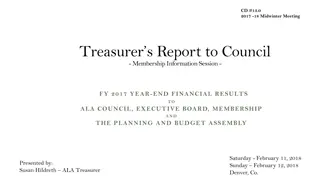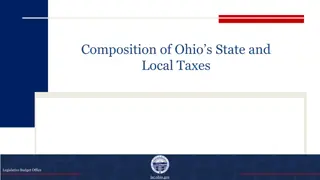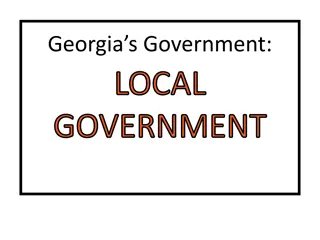Revenue System of Local Self-Governments in Bulgaria
The revenue system of local self-governments in Bulgaria has evolved since the democratic changes in 1990, focusing on decentralization and fiscal autonomy. Key documents and programs have shaped the revenue mechanisms, allowing municipalities to set local fees, introduce debt financing, and gain taxation powers. Recent legal acts have further refined financial procedures in alignment with EU directives. This conference will explore the progress and challenges in Bulgaria's local revenue system.
Uploaded on Sep 24, 2024 | 0 Views
Download Presentation

Please find below an Image/Link to download the presentation.
The content on the website is provided AS IS for your information and personal use only. It may not be sold, licensed, or shared on other websites without obtaining consent from the author. Download presentation by click this link. If you encounter any issues during the download, it is possible that the publisher has removed the file from their server.
E N D
Presentation Transcript
REVENUE SYSTEM OF LOCAL SELF- GOVERNMENTS IN BULGARIA International Scientific Conference entitled Income systems of local self-governments in selected countries Siedlce Institute of Political Science and PublicAdministration Faculty of Social Science Siedlce University of Natural Sciences and Humanities (UPH) 27-28 September 2023 1
INTRODUCTION The policy aimed at decentralization in Bulgaria started with the democratic changes in 1990: European Charter for Local Self-Government 1995 Fiscal Decentralisation Programme 2002 Main documents defining the revenue system of Bulgarian municipalities: the Local Self-Government and Local Administration Act, the Municipal Property Act, the Municipal Budgets Act, the Local Taxes and Fees Act, the Municipal Debt Act Concept for Financial decentralisation and a Programme Fiscal Decentralization - 2002 2
MAIN RESULTS FROM THE FISCAL DECENTRALIZATION` PROGRAMME Through the amendments to the Local Taxes and Fees Act (LTFA) entered into force in 2003 municipalities shall be entitled to determine the basis and amounts of local fees listed in the LTFA and shall introduce prices for other services as well by Decree of the Municipal Council. Adoption of the Municipal Debt Act (2005) - the first document adopted by the Bulgarian government specifying the process of debt financing of municipalities. It regulates the matters related to the types of debt, procedures for debt assumption, limitations on debt assumption, procedures for choosing a financial intermediary. In 2007, amendments and supplements to the Constitution of the Republic of Bulgaria were adopted , since by Art. 141 municipal councils shall be entitled to determine the amount of local taxes under the conditions, in accordance with the procedure and within the limits established by the law. Bulgarian municipalities have received for the first time real power to impose taxes. Local authorities shall set tax rates in accordance with the legal restrictions, but do not have competence in determining the types and taxable base of local taxes. 3
MAIN RESULTS FROM THE FISCAL DECENTRALIZATION` PROGRAMME The main procedural actis the Tax and Social Security Procedure Code (TSSPC). Revenue authorities have certain powers laid down in the TSSPC and substantive Tax Law. The newest legal act concerning local finances is the Public Finances Act. Its provisions entered into force in 2014. The Public Finance Act transposes the main provisions of Council Directive 2011/85/EU of 8 November 2011 on requirements for budgetary frameworks of the Member States and Council Regulation (EC) No 479/2009 of 25 May 2009 on the application of the Protocol on the excessive deficit procedure.By the adoption of the Public Finances Act, the Municipal Budgets Act was repealed. 4
STRUCTURE OF THE MUNICIPAL REVENUE SYSTEM According to Art. 45 of the Public Finance Act, the municipal budget includes revenues from: local taxes; fees; services and rights provided by the municipality; disposal of municipal property; fines and financial penalties; interest and penalties; other receipts; financial aid and donations. Municipal budgets also receive revenues from state transfers, including revenues from a general equalization subsidy, from a subsidy for the financing of activities delegated by the state, from a subsidy for the financing of capital expenditures and other transfers. According to the European Charter for Local Self-Government "Local authorities shall be entitled, within national economic policy, to adequate financial resources of their own, of which they may dispose freely within the framework of their powers . 5
STRUCTURE OF THE REVENUE IN LOCAL BUDGETS FOR THE PERIOD 2015-2020 The dependence of Bulgarian municipalities on state transfers has been increasing during the investigation period. While in 2015 state transfers constituted 59% of municipal revenues, at the end of 2020 the share of transfers in municipal revenues reached 68%. The main reason is the growth of the general subsidy for activities delegated by the state. As a result of an increase in the minimum monthly salary and an increase in the values according to the minimum standards laid down in the mechanism for determining the subsidy in the municipal budgets, revenues from state transfers dominate. 6
STRUCTURE OF LOCAL TAX REVENUES FOR THE PERIOD 2015-2020 The municipal budget receives the following local taxes : immovable property tax; inheritance tax; gift tax; tax on acquisition of property for consideration; vehicle tax; patent tax; tourist tax; tax on passenger taxi transport; other local taxes determined by law. An analysis of financial information shows that revenues from inheritance tax and gift tax are extremely low. They constitute less than 0.5% of the tax revenues of the municipalities. They are excluded from the analysis of the dynamics of municipal tax revenues. 7
STRUCTURE OF LOCAL TAX REVENUES FOR THE PERIOD 2015-2020 The fiscally significant tax revenues for municipal budgets are the revenues from immovable property tax, the revenues from the tax on acquisition of property for consideration and the revenues from vehicle tax. The revenues from vehicle tax recorded the most stable values for the period and constitute between 30 and 34% of municipal tax revenues. The increase in revenues from this tax is due to the introduction of new criteria for eco-compliance when determining the tax liability. Revenue from immovable property tax ranges between 32% and 37%, and revenue from tax on acquisition of property for consideration ranges between 29% and 31%. Revenue from transaction tax are highly volatile and depend on the development and on the phase of the real estate market. The crisis related to the spread of COVID-19 caused an additional revival of the real estate market in large and medium-sized municipalities, and this reflected in higher revenue from transaction tax at the end of 2020. Revenues from the patent tax and from the tax on passenger taxi transport are more significant in large municipalities characterised by well-developed local businesses. For this reason, their share in municipal tax revenues is not high. Revenue from these taxes equals 2-3% of municipal tax revenue. 8
COLLECTABILITY OF REVENUE FROM IMMOVABLE PROPERTY TAX AND VEHICLE TAX The collection rate of the two main municipal taxes reported an increase during the investigation period. The best values are reported in 2019, when the revenue from vehicle tax reaches a collection rate of nearly 71%, and the revenue from property taxes nearly 75%. Data from the end of 2020 shows that opportunities are still being reported to increase tax collection rate and achieve higher revenues from taxes being investigated. At the level of an individual municipality, appropriate measures should be taken to improve collection rates, including sending notice for voluntary enforcement of tax liabilities. 9
SHARE OF OWN LOCAL REVENUES IN TOTAL REVENUES The indicator "Share of own local revenues in total revenues" represents the share of municipal own revenues (tax revenues, non-tax revenues and revenues from municipal fees) compared to total budget revenues (own revenues, reduced by one- time aid and donations from abroad and transfers to municipalities). The results of the analysis of this indicator show to what extent the municipalities are independent from the transfers of the central authorities and could conduct a relatively independent financial policy. 10
SHARE OF OWN LOCAL REVENUES IN TOTAL REVENUES The analysed data show a deterioration in the financial independence of Bulgarian municipalities and a decrease in the share of own revenues in total municipal revenues from 40.17% to 30.37%. This also shows the increasing dependence of the local authorities in Bulgaria on the decisions of the central authorities and implies taking measures to restart fiscal decentralisation in Bulgaria. It should be emphasised that after 2008 no significant measures to increase the financial independence of local authorities in Bulgaria have been taken into account. New local taxes have been being introduced such as tourist tax, patent tax and tax on taxi transport. Revenues from these taxes, however, have a symbolic meaning for the budgets of most municipalities and do not imply a significant change in the financial situation in the structure of own revenues. 11
LOCAL AUTONOMY INDEX The index was to provide a basis on which to analyse and report changes in the extent of decentralisation in the countries under scrutiny. The measurement of decentralisation was to go beyond recording the share of funds managed by local authorities and also to capture the extent to which local authorities have a say in how these funds are spent. The project covered 39 countries: all 28 EU member states together with the 3 European Economic Area (EEA) countries (Norway, Iceland, and Liechtenstein) plus Switzerland, a member of the European Free Trade Association (EFTA). Additionally, Albania, Macedonia, Moldova, Georgia, Serbia, Turkey, and Ukraine were included (Andreas Ladner & Nicolas Keuffer (2021)). In 2021, the second report dedicated to Autonomy Index was published. The analysis included database includes 57 countries, from 1990 to 2020, i.e. almost all the member States of the EU (27), of the CoE (47) and of the OECD (37). Completely in line with the most important aspects of local autonomy discussed in the literature, the measurement of local autonomy was based on a code book containing 11 variables. Two of the variables (PS and EPD) consisted of 12 sub-variables. For each variable, clear indications regarding the meaning of the categories were given (Ladner, Keuffer, and Baldersheim 2016). 12
LOCAL AUTONOMY INDEX One of the variables forming LAI and determining the nature of the revenue system of local authorities in the respective country is the fiscal autonomy variable. The variable ranges from no autonomy at all to local government sets rate and base of more than one major tax (such as personal income, corporate, value added, property or sales tax) (LAI II Project, p. 34). The values of this variable range between 0 and 4. For the period 2015-2020, the value of the Fiscal autonomy variable for Bulgaria is 1. The countries having the highest value for the period (4) are Liechtenstein and Switzerland. Countries having a value of 3 on this indicator are Sweden, Austria, Finland. The average value of the variable for all countries included in the research is 1.65%. We can draw the conclusion that on the basis of the fiscal autonomy variable, Bulgaria comes close to the average values for the representative sample. 13
LOCAL AUTONOMY INDEX Another variable forming the Local Autonomy Index is the Financial transfer system. The variable present the proportion of unconditional financial transfers to total financial transfers received by the local government. The assessment of the variable is between 0 and 3. For the period 2015-2020 the variable financial transfer system for Bulgaria is 0, conditional transfers are dominant in budgets of local authorities. Out of the European countries, only Hungary and Ireland report values of 0. The average value of the variable for the investigation countries for the period is 1.58. The countries reporting the maximum value of the variable are Norway, Malta, Greece, France, etc. The overall score of the Local Autonomy Index (based on calculations for each individual variable) for Bulgaria is 59.66. The average for the countries in the research is 57.16. The countries having the lowest reported values of the index are Russia (37.87) and Belarus (38.49). The countries having the highest values of the indicator are Sweden (76.19), Switzerland (76.98), Denmark (75.59) and Iceland (76.21). And based on the values of the Local Autonomy Index, it can be concluded that Bulgaria is approaching the average values reported for the investigation countries. 14
RECOMMENDATIONS FOR INCREASING MUNICIPAL REVENUES IN BULGARIA Substantial recommendations as regards the current legislation in the field of local taxes, including fees, have been made in the subsequent assessment of the impact of the Local Taxes and Fees Act, which is made according to the Statutory Instruments Act in the Republic of Bulgaria . The conclusion is that, in general, the level of financial decentralization in Bulgaria can be assessed as low. Bulgarian municipalities are highly dependent on state transfers. Moreover, in small and medium-sized municipalities, revenues from state transfers often make up nearly 70% of municipal revenues. In order to strengthen the financial independence of Bulgarian municipalities and for local authorities to make relatively independent decisions about the goods, services and infrastructure they provide, it is necessary to look for sources of municipal revenues. Introduction of shared taxes - Local authorities in many European countries receive revenue from shared taxes. The central authorities most often shares revenues from corporate tax and personal income tax. Examples of countries where tax revenue is shared are Germany, Poland, Portugal, Slovenia and the Czech Republic. 15
RECOMMENDATIONS FOR INCREASING MUNICIPAL REVENUES IN BULGARIA For several years now, the National Association of Municipalities in the Republic of Bulgaria has been sharing and working for the introduction of new models for sharing some of the tax revenues between the state and municipalities (for example, personal income tax, corporate tax) and for expanding the powers of local authorities in the collection rate of these sources of revenue which are new for them. According to a 2018 report of the Institute of Market Economy, "There is some consensus among experts that a good first step in the direction of fiscal decentralisation would be to share one-fifth of revenue from income tax with the municipalities. With revenues from the personal income tax set in the 2018 budget of BGN 3.372 million, the transfer of such a portion of the revenues would increase the municipalities' own revenues by nearly BGN 675 million or by 30.4%". The main questions before this proposal are: Determining the methodology according to which the funds will be distributed - on the basis of pre-set criteria, similar to the criteria laid down in the determination of state transfers or on the basis of the place of receipt of revenue. Determining the nature of the funds received - whether they will be used for targeted or non-targeted purposes. The authorities that will be responsible for the administration and control of the process. 16
RECOMMENDATIONS FOR INCREASING MUNICIPAL REVENUES IN BULGARIA Other proposals for increasing municipal revenues are updating the tax assessment base of immovable property. The tax assessment base has not been updated since 2006, and market prices are many times higher than tax assessments in many municipalities. The update of the tax assessment will result into more revenue from immovable property tax and tax on acquisition of property for consideration. Also, revenue can be increased by improving collection rate and introducing new taxes. However, the introduction of new taxes should be done very carefully and after a detailed analysis of the social tolerance of citizens. Financial Law has a lot of challenges nowadays due to the complicated correlations and relations with the EU Law, Financial System and Public Finances of the EU. 17
Assoc. Prof. Savina Mihaylova-Goleminova PhD s.mihaylova@feb.uni-sofia.bg Assistant Prof. Desislava Kalcheva PhD d.kalcheva@feb.uni-sofia.bg Department Industrial Economics & Management Faculty of Economics and Business, Sofia University Master s Programme Economics&Management of Public Resources Sofia University " St.Kliment Ohridsky", Bulgaria 18























